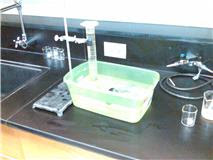Cellular respiration was showed by using ice cold water to be able to show the amount of respiration. The experiment was used to test the difference in respiration between germinating peas and non-germinating peas. The non-germinating peas will respire more since they do not have as mush water retained within them already like the germinating peas do. Glass beads and the germinating or non-germinating peas were set into beakers to find the same amount of volume. The usage of glass tubes, glass beads, germinating peas, non-germinating peas, along with KOH (Potassium Hydroxide), ice cold water in a large 3 inch tall bucket, stoppers, long thin tubes for the respirators, masking tape, cotton balls, and washers to be as weights to weigh the tubes down from floating.
First the germinating peas, non-germinating peas, and non-germinating and glass beads were set into the beakers to find the right volume. Then they were each set into the three tubes with the cotton ball of KOH and a small barrier of cotton between them and the peas and beads. The water was regulated at 4 degrees Celsius with the ice and all. After the stoppers were placed with the respirator pipes, they were set into the ice cold water solution to be tested.
The data collected over the allotted time of 12 minutes showed that the one with the most respiration was the one with the germinating peas. They respired more than the non-germinating peas.
Above is the data collected throughout the experiment.
The lab helped explain the process of cellular respiration by showing that using certain things like the KOH, the water temperature, and germinating or non-germinating peas can help vary the amount of respiration for each. The fact of if the peas were germinating or not can change the outcome from the fact that they already retain water from being in the germinating process.
Thursday, November 24, 2011
Saturday, August 27, 2011
Enzyme Lab
In our Biology class my lab partner and I studied the decrease in ML (milliliters) of water from mixing H2O2 or hydrogen peroxide together with Yeast. Our set up consisted of a small tub, a graduated cylinder containing of 100 ML of water, a holder for the cylinder, a small tube to connect another cylinder to the graduated cylinder, a syringe, H2O2, and yeast. First we submerged the graduated cylinder in the tub of water and flipped it to keep the water within it, we hooked it onto a stand to make it stay in place. Next we started with 1 ML of yeast and added it to 10 ML of hydrogen peroxide capped it and set the tubing into the graduated cylinder. For the course of 5 minutes we counted how far the water went down in the cylinder. The first trial it had gone down 42 ML, the second trial we put .75 ML of yeast and it had gone down only 33 ML in 5 minutes. We did the same test but changed the amount of yeast for each third was .50 ML and it had gone down 15 ML, then our fourth trial for .25 ML it had only gone down 12 ML in the allotted time of 5 minutes. Our project showed that the fewer enzymes in the concoction, that it will show that the yeast and H2O2 to react together and have fewer bubbles to rise and cause the water level to lower.
Here is a photo of our lab set up.
The level the water stood at after the five minutes had passed.
Here is a photo of our lab set up.
The level the water stood at after the five minutes had passed.
Sunday, August 14, 2011
Pill Bug Lab
While in Ap Biology we were investigating the more preferable habitats by Pill Bugs. My lab partner and I used a small tray with two connected circles on it. We chose two paper filters and ran water over one and left the other filter dry, we inserted them into the tray and let five different sized Pill Bugs into the tray. We studied there ways of movement to see which habitat they preferred more, over the course of twenty minutes we collected data once every minute to see where the Pill Bugs would scurry to. As they roamed around their new environments, we noticed a majority of the time they had collected on the Wet Filter side more often than the Dry Filter side. Pill Bugs already enjoy moist places, but they usually are dark as well. Our results showed us that over the course of the allotted time, the Pill Bugs had assembled on the Wet Filter side for a total of sixty-seven percent of the time. Also the Pill Bugs were on the Dry side thirty-three percent of the time. Therefore our conclusion is that they still stay true to their natural environment and that happens to be dark, moist places. Our data may have been better if we possibly had more items to test the Pill Bugs with. Maybe even more Pill bugs to be able to see how they interacted with one another and in a environment they are not quite used to as well.
Graph above shows the data collected over twenty minutes.
Graph above shows the data collected over twenty minutes.
Subscribe to:
Comments (Atom)





